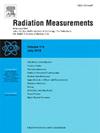Development of an algorithm for automated estimation of fetal head dose in pelvimetric CT scans based on geometrical considerations
IF 2.2
3区 物理与天体物理
Q2 NUCLEAR SCIENCE & TECHNOLOGY
引用次数: 0
Abstract
This study addresses radiation safety for fetal exposure during pelvimetry Computed Tomography (CT) scans in pregnant women, specifically in the Moroccan context. While previous studies in Morocco have utilized Monte Carlo simulations or established formalisms for effective dose estimations, none have computed a size-adjusted dose estimates for the fetal head using an automated method. The goal of this research was to enhance fetal radiation safety by developing a Python-based script for automating fetal head contouring and estimating a Size-Adjusted Fetal Head Dose (SAFHD). The automation process addresses challenges posed by the presence of other bone structures in the pelvis, therefore, a custom Python script was developed for image preprocessing, including normalization, region of interest (ROI) selection, binary image creation, morphological processing, mask creation, and region labeling. These steps ensured detection and isolation of the fetal head region. The SAFHD method adjusts the dose estimation for the fetal head based on its unique anatomical characteristics, adapting the conventional SSDE framework. This retrospective study used datasets comprising axial CT images from 136 pregnant women, all scanned using a standardized 80-detector CT scanner. The process of estimating SAFHD included several key steps: (1) calculating the pelvis SSDE using the AAPM Report 220 method for adult body CT scans, (2) introducing a correction factor (k) to adjust the pelvis SSDE to fetal head dose from previous findings, (3) performing automated fetal head contouring to extract the lateral (LAT) and anteroposterior (AP) dimensions of the fetal head, (4) calculating the water-equivalent diameter (Dw) from LAT and AP values and (5) using a size-specific conversion factor derived from interpolated pediatric head data in AAPM reports 220 and 293 to complete the SAFHD estimation. The automated method showed strong correlation with manual measurements taken by ten observers, with correlation coefficients of 0.96 for LAT and 0.94 for AP dimensions. The intraobserver agreement for Dw measurements was highly consistent, with ICC values ranging from 0.960 to 0.999. The final SAFHD values, derived using the correction factor and size conversion based on fetal head dimensions, correlated strongly (0.98) with manual estimations. By incorporating both maternal pelvis dose and specific fetal head dimensions, the SAFHD estimation offers a promising tool for clinicians to accurately estimate fetal radiation doses and verify dose limits, minimizing radiation-related risks to the fetus.
基于几何考虑的骨盆CT扫描中胎儿头剂量自动估计算法的发展
本研究解决孕妇骨盆计算机断层扫描(CT)扫描期间胎儿暴露的辐射安全问题,特别是在摩洛哥的背景下。虽然摩洛哥以前的研究利用了蒙特卡罗模拟或建立了有效剂量估计的形式,但没有一项研究使用自动化方法计算出胎头的调整剂量估计。本研究的目的是通过开发一个基于python的脚本,用于自动绘制胎儿头部轮廓和估计大小调整的胎儿头部剂量(SAFHD),从而提高胎儿的辐射安全性。自动化过程解决了骨盆中存在其他骨骼结构所带来的挑战,因此,开发了用于图像预处理的自定义Python脚本,包括归一化、感兴趣区域(ROI)选择、二值图像创建、形态学处理、掩码创建和区域标记。这些步骤确保了胎儿头部区域的检测和分离。SAFHD方法根据胎儿头部独特的解剖特征调整剂量估计,适应传统的SSDE框架。本回顾性研究使用的数据集包括136名孕妇的轴向CT图像,所有孕妇都使用标准化的80个探测器CT扫描仪进行扫描。估算SAFHD的过程包括几个关键步骤:(1)使用AAPM Report 220方法计算成人身体CT扫描的骨盆SSDE,(2)引入校正因子(k)根据先前的发现调整骨盆SSDE与胎头的剂量,(3)执行自动胎头轮廓提取胎头的侧位(LAT)和正位(AP)尺寸。(4)根据LAT和AP值计算水当量直径(Dw);(5)利用AAPM报告220和293中插值的儿童头部数据得出的特定尺寸转换因子来完成SAFHD估计。自动化方法与10名观测者进行的人工测量具有很强的相关性,LAT和AP维度的相关系数分别为0.96和0.94。观察者内部对Dw测量的一致性是高度一致的,ICC值在0.960到0.999之间。最终的SAFHD值是使用校正因子和基于胎儿头尺寸的大小转换得出的,与人工估计有很强的相关性(0.98)。通过结合产妇骨盆剂量和胎儿头部的具体尺寸,SAFHD估计为临床医生准确估计胎儿辐射剂量和验证剂量限制提供了一个有前途的工具,从而最大限度地减少与辐射有关的胎儿风险。
本文章由计算机程序翻译,如有差异,请以英文原文为准。
求助全文
约1分钟内获得全文
求助全文
来源期刊

Radiation Measurements
工程技术-核科学技术
CiteScore
4.10
自引率
20.00%
发文量
116
审稿时长
48 days
期刊介绍:
The journal seeks to publish papers that present advances in the following areas: spontaneous and stimulated luminescence (including scintillating materials, thermoluminescence, and optically stimulated luminescence); electron spin resonance of natural and synthetic materials; the physics, design and performance of radiation measurements (including computational modelling such as electronic transport simulations); the novel basic aspects of radiation measurement in medical physics. Studies of energy-transfer phenomena, track physics and microdosimetry are also of interest to the journal.
Applications relevant to the journal, particularly where they present novel detection techniques, novel analytical approaches or novel materials, include: personal dosimetry (including dosimetric quantities, active/electronic and passive monitoring techniques for photon, neutron and charged-particle exposures); environmental dosimetry (including methodological advances and predictive models related to radon, but generally excluding local survey results of radon where the main aim is to establish the radiation risk to populations); cosmic and high-energy radiation measurements (including dosimetry, space radiation effects, and single event upsets); dosimetry-based archaeological and Quaternary dating; dosimetry-based approaches to thermochronometry; accident and retrospective dosimetry (including activation detectors), and dosimetry and measurements related to medical applications.
 求助内容:
求助内容: 应助结果提醒方式:
应助结果提醒方式:


